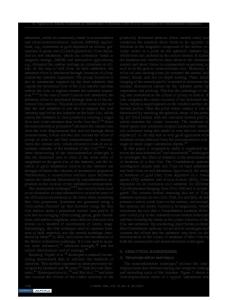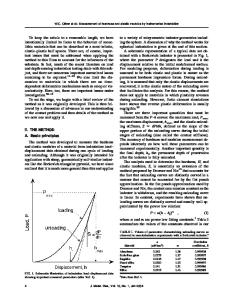Evaluation of elastic modulus and hardness of thin films by nanoindentation
- PDF / 1,570,320 Bytes
- 5 Pages / 612 x 792 pts (letter) Page_size
- 16 Downloads / 412 Views
Mariusz Martyniuk School of Electrical, Electronic and Computer Engineering, The University of Western Australia, Crawley, WA 6009, Australia
Han Huang and Xiao Zhi Hu School of Mechanical Engineering, The University of Western Australia, Crawley, WA 6009, Australia (Received 7 May 2004; accepted 12 July 2004)
Simple equations are proposed for determining elastic modulus and hardness properties of thin films on substrates from nanoindentation experiments. An empirical formulation relates the modulus E and hardness H of the film/substrate bilayer to corresponding material properties of the constituent materials via a power-law relation. Geometrical dependence of E and H is wholly contained in the power-law exponents, expressed here as sigmoidal functions of indenter penetration relative to film thickness. The formulation may be inverted to enable deconvolution of film properties from data on the film/substrate bilayers. Berkovich nanoindentation data for dense oxide and nitride films on silicon substrates are used to validate the equations and to demonstrate the film property deconvolution. Additional data for less dense nitride films are used to illustrate the extent to which film properties may depend on the method of fabrication.
I. INTRODUCTION
There is considerable interest in the use of instrumented nanoindentation as a means of characterizing mechanical properties of small-scale specimens, notably Young’s modulus E and hardness H.1,2 This is especially true of thin films on substrates. The practical importance of thin film systems makes it desirable to determine closed-form relations for E and H in terms of film thickness and properties of the constituent materials. Analytically, the problem is intractable because of the complicating influence of the film/substrate interface on the elastic and plastic stress fields. Some empirical relations have been proposed,3–11 basically using variations on a rule of mixtures in combination with experimental or finite element modeling data. Any one of these empirical relations can generally be made to fit any given data set,
to a greater or lesser extent.3 Deconvolution of film properties from measurements on the composite film/ substrate bilayer is an ultimate goal. In this study we propose a variant formulation for determining E and H of thin films from nanoindentation measurements. The approach follows that used by Hu12 for spherical indenters on bilayers, here modified to accommodate the case of fixed-profile indenters, e.g., Berkovich or Vickers. A power-law function is used to relate E and H for the film/substrate composite to values for the constituent materials, with exponent dependent exclusively on indenter penetration relative to film thickness, h/d. Advantages of this approach are that the formulation is simple, the material and geometrical factors are separable, and the same formulation applies equally well where the stiffer/harder component comprises either the film or the substrate. Data for oxide and nitride films on a silicon substrate are used to eva
Data Loading...











